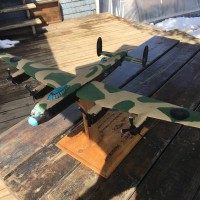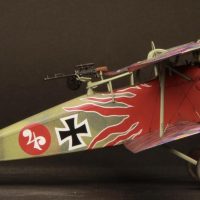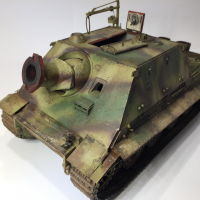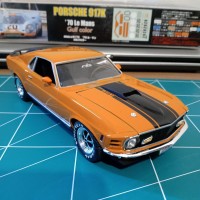MONOGRAM 1/24 DUESENBERG 1934 MODEL SJ ROADSTER
The Vehicle:
E. L. Cord, owner of the Auburn Automobile Company, and other transportation firms, bought the Duesenberg Motor Corporation on October 26, 1926, for the Duesenberg brothers' engineering skills, talent and brand name. He intended to produce a car to rival the size, power, and luxury of top European brands such as Hispano-Suiza and Rolls-Royce.
Fred's brother August, who had played an important role in the development of the Model A and its variant, the rare X, had nothing to do with the initial design of the J and had no formal connection with Duesenberg, Inc. until later. According to the expert Marshall Merkes, "Cord did not want Augie around. However, all Duesenberg racing cars produced after 1926 were built by Augie in an enterprise that functioned separately, and in a building apart from the main Duesenberg plant." He was also responsible for a number of engineering achievements like the superchargers developed for both the Auburn and Cord motorcars.
After Cord's takeover, the new company was renamed "Duesenberg, Inc." Fred Duesenberg continued in the new organization with the title of vice president in charge of engineering and experimental work until he died of pneumonia on July 26, 1932, resulting from injuries sustained in an automobile accident in which he was driving a Murphy SJ convertible. Following his death, Augie, took over Fred's duties as chief engineer and Harold T. Ames became president of Duesenberg, Inc.
The Duesenberg Model J luxury automobile was intended to compete with the most luxurious and powerful cars in the world, it was introduced in 1928, the year before the stock market crash that led to the Great Depression.
The 420 cu in straight eight Model J motor was based on the company's successful racing engines of the 1920s; though designed by Duesenberg they were manufactured by Lycoming, another company owned by Cord. In normally aspirated form, it produced 265 horsepower from dual overhead camshafts and four valves per cylinder. It was capable of a top speed of 91 mph and 79 mph in 2nd gear. Other cars featured a bigger engine but none of them surpassed its power. It was both the fastest and most expensive American automobile on the market.
A Duesenberg marketing slogan was that the only car that could pass a Duesenberg was another Duesenberg—and that was only with the first owner's consent.
The powerful 320 hp supercharged "SJ" model developed by Fred Duesenberg and introduced in May 1932, was capable of 104 miles per hour in second gear with a top speed of 135–140 mph in third. Performance included zero-to-60 mph time of eight seconds and 0–100 mph in 17 seconds in spite of the unsynchronized transmissions, at a time when even the best cars of the era were not likely to reach 100 mph. It was said that when the supercharger cut in, the car "howled like a banshee."
The SJ's supercharger was located beside the engine; the vertical driving shaft necessitated a redesigned exhaust manifold arrangement; originally this took the form of a one-piece eight into one Monel manifold that re-routed the exhaust away from the engine, outside the engine compartment and through a single hole in the right front fender. The eight port manifold was found to be prone to cracking and was quickly superseded by a second manifold arrangement that routed four branches through the right side panel of the hood and right front fender. At least one supercharged car retains its original eight port manifold while most can be recognized by the four exposed exhaust pipes encased within bright flexible metal conduit tubes, a design which Cord registered as a trademark and used in his supercharged Cords and Auburns. Only 36 SJs were ever built.
Ultimately it was the newly-wealthy Hollywood elite who kept Duesenberg alive as the Depression deepened, and through much of the 1930s. It was so imposing that many Hollywood stars, such as James Cagney, posed next to the car to promote their careers. Once he "hit" with "It Happened One Night," Clark Gable did a few ads for the SJ since he owned one.
The final evolution of the Duesenberg engine was ram-air intakes, which were added to some of the last supercharged models to produce 400 hp, referred to as "SSJ".
Duesenberg ceased production in 1937 after Cord's financial empire collapsed. Duesenbergs became far less popular during World War II; by 1942, used specimens were abundant and cheap, with advertised prices averaging around $700 ($13,053 in 2024 dollars) for cars in excellent condition. A few used Model Js were advertised for around $300 to $400, with some ultimately selling for only $100 or $200.
Business rebounded in the 1950s, when classic and vintage cars became popular among collectors. Several Model Js were advertised in The New York Times in the fall of 1950, at prices as low as $500, though an exceptional restored example could exceed $2,000 ($25,328 in 2023 dollars) which was still within the reach of the average working American.
In 2018 a Duesenberg SSJ formerly owned by Gary Cooper was sold at auction for $22 million, making it the most expensive American car ever sold.
Liberace used a replica Duesenberg SJ encrusted with Austrian rhinestone crystals during his stage performances. The vehicle later went on to be exhibited at the Liberace Museum in Las Vegas, Nevada, and at The Cosmopolitan of Las Vegas; its current location is at the "Liberace Garage" in Las Vegas.
The Kit:
This is one of the Monogram “Classic American Cars” originally released in the 1960s. The Duesenberg Model J was also released at this time.
The kits are “1960s fit,” which means they should be treated like a modern limited-run kit in order to get the best final result.
The plastic does not respond to modern “hot” glues like Tamiya Extra-thin. I assembled this kit using CA-glue. I did not install the engine, opting for a “curbside” model.
I read that Clark Gable's SJ was “plum colored” and decided to do what might have been his (He definitely drove his at 150mph on the road out to Palm Springs once it was paved). I used Vallejo “plum red”, while painting the seats with Gunze “sail color” for the leather covering. I closed up the rumbleseat option, which involved filling the gap on all four sides of the trunk lid. I used a Molotow Chrome Pen to do the chrome strips that were molded on the body.
Another in the "Cars I Would Buy If I Was Sole Winner of The Powerball" Collection.














I picked up this kit, on my last visit to the states. It's the first edition. Obviously, my plan is to build it, and not have it stored on a shelf, gathering dust?
I love what you've done here. The elements of history, just gratify what the manufacturers did, and Monogram tried to reproduce.
I love it mate, and I hope mine turns out, half as good as yours 🙂
Was this kit molded in yellow? I think I built this kit in high school. Yours looks great. Wish I'd known about the pen to do chrome trim. 420 cubic inch straight eight, what a beast!
That's the Model J.
Sharp work, Tom. I always wanted one of those Monogram classic car kits as a kid but never got one.
No wings, no tail...but awesome build and paint job on the Duesenberg.
I never knew you did cars as well. You've captured the style and elegance of the prototype perfectly.
Certain ones. The ones I wish I could own as a 1:1. Just picked up a new (2022) mold Revell 1961 Jaguar XK-E, which I shall build in memory of a 1967 road trip I made in one - 18 hours to do 1,800 miles between Berkeley and Denver, traveling with The Hippest Hippie Chick In America (everyone who met her agreed - she's been married to a Very Successful Doctor in NYC for the past 50 years). Back then the cops weren't as "hooked in" as they are now and you could get away with it. (And it held together the whole way!)
Excellent result and great history of a car I didn't know it existed, Tom!
Very cool, TC @tcinla. Whaaat? No wings?
Excellent work on this Duesenberg, Tom @tcinla
Definitely something different than your usual builds but equally beautiful.
Those large side skirts could be considered as wings.
They could!
Great work on this classic kit and an interesting history. I wouldn’t be surprised if J. Leno has one in his “garage”, although he may have modified it a little. I’m assuming the white walls are moulded plastic?
The white walls are moulded plastic and Jay does indeed own one. He used to come into Burbank House of Hobbies during early afternoon before the show taped (the studio was eight blocks from the shop) and once invited those "regulars" there to come out to the "garage" (a hangar at Burbank Airport). I got a 5-minute ride in the Duesy.
Excellent model of a classic car.
Looks great!, didn't Monogram do a Cord kit?
They did - I reviewed it here - done as Amerlia Earhart's Cord 812S.
Too cool. Yeah, if I can't have the real thing I get busy in my fantasy workshop!
Nice job, Tom.
I Included some pics from our Lycoming "museum". Not sure if this is exactly what would have been in your build car but there still cool to see.
3 attached images. Click to enlarge.
Wow - the 1929 Packard in the first two shots is the choice Monogram did with their kit of that in this series.
What a nice build Tom. Thanks for all the information about this lovely car!
Tom,
Tom Cleaver (@tcinla)
You have done a fantastic job with your Dewsie. It is a beautiful car that I have had the opportunity to work on once. Years ago I was working in an automotive machine shop and we had a straight 8 Duisenberg cylinder head come in for a complete overhaul. I was amazed at how much engineering work went into the original design. It had 4 valves per cylinder exactly like you described. It was much longer and heavier than what I was used to working on.
A gentleman who was living in the Spruce Creek Fly Inn was restoring one. Otherwise I would have never had the opportunity.
Funny thing you mentioned Jay Leno. It is indeed a small world.
I went to basic training with his cousin who was named Kevin. You can see the family resemblance in his photo. Kevin told me all about Jay’s car collection. He was especially fond of his Mopar Hemi and 440 powered cars that were ultra rare and equally expensive.
This is me. Back when my hair was dark and thicker.
Here’s our graduation book from Fort Knox.
These are some of the more memorable moments.
And this is the man who was the Devil himself. SFC Elemore.
He was brutal to all. He did not discriminate.
But he was also one of the men that I have the utmost respect for. Even to this very day.
I’m definitely clicking on a few of the various like buttons. You hit a home run here buddy.
Oh man, getting a shot from one of those @@#$#$#@! guns! Flinch and your bicep gets sectioned. I used to hate those things.
Tom Cleaver (@tcinla)
I hated them too...they left a huge welt on your skin where the vaccine was forcefully blown into you. It felt almost like a bee sting. I don't know of anyone other than the medics who were using them that liked them. Mass production use. Sort of reminds me of cattle...
Before they started giving us the shots using the air gun they took a sheet of paper and sliced it cleanly in half using the air gun. They told us not to move at all because it would slice us wide open.
Sure enough though…. There’s always one. He moved and it sliced his shoulder wide open. He ended up with a bunch of stitches.
I remember that we got 16 shots in one day but that might have happened once I was getting ready to deploy overseas later on in my career.
I know that immediately after we got our injections they immediately took us outside and PT'd the $h1T out of us.
For about an hour. Basic training. Boot Camp. Gotta love it. Some of my most memorable things happened there.
Our 16 weeks was interrupted by a 12 hour “family day”. Otherwise it was business as usual. The Drill Sergeants we had were incredible. They could be your worst nightmare and then a few minutes later they would act like a father figure to us.
I have the utmost respect for anyone who has graduated from the Drill Sergeants Academy and have trained soldiers , Marines, Sailors or Airmen.
My Dad was one ….. and he raised me like I was in Basic training so it wasn’t all that hard for me. The physical training was the hardest part. The mental part was a breeze. I was used to it.
beautiful red car Tom!